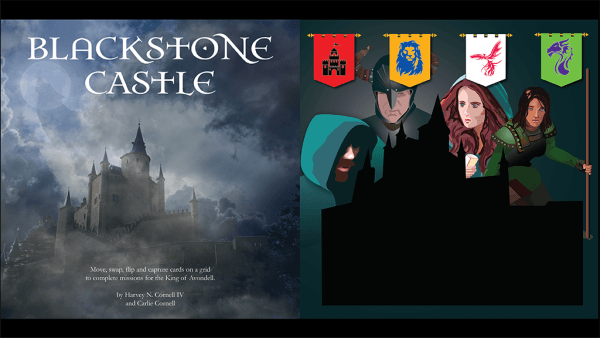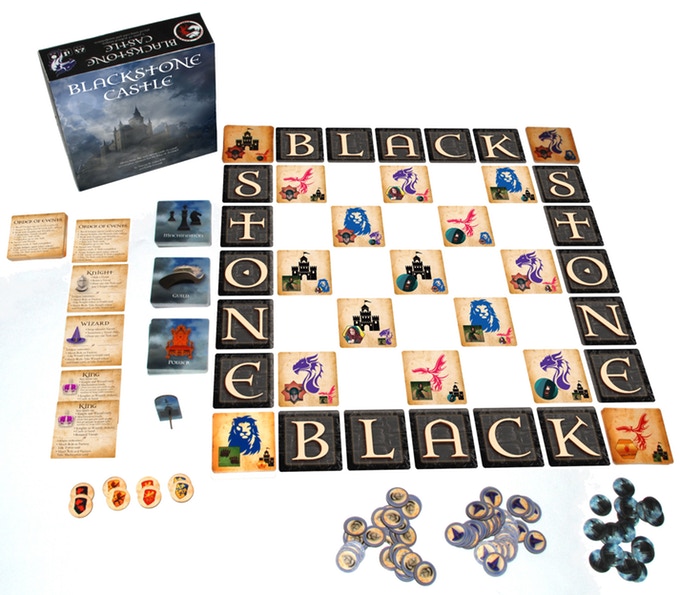Blackstone Castle Preview: Intrigue, Manipulation, and Power

Win the guilds to your side, secure the favor of the King, and maneuver and manipulate your way to victory.
Strategic and logical, Blackstone Castle is a game of grid manipulation in which all the information is open and available to players. Currently on Kickstarter, it is tense, challenging, and layered.
Gameplay
The board is made up of five-by-five grid. Tiles spelling out the word ‘black’ are placed along the top and bottom and tiles spelling out the word ‘stone’ are placed along the two sides. These words are used for coordinates for grid locations. Thirteen vassal cards are then placed within the grid. There are several pieces of information on a vassal card: its faction, its role, and the faction and role of the vassal on the opposite side of the card.
Each player begins the game with a wizard household card, a knight household card, and two king cards. On your turn you earn one wizard token and one knight token from their respective house cards and for each task card that has been placed beneath them. However, you can never have more of either token than you have of king cards.
There are three different types of task cards: guild, power, and machination. Your goal is to complete task cards in order to score points. Power cards, when completed, become king cards; machination cards usually do not go under any of your house cards but are worth the most victory points; and guild cards, when completed, will typically either join your knight household card or your wizard household card.
To complete a task card you must move two vassals on the board to the locations listed on the task card. The card will also list what role and/or faction these vassals must belong to. You may also need to discard a third vassal of a specific faction or role that you have retained. On your turn you may spend a knight token to retain a vassal, taking it from the grid and placing it in front of you.
You also spend knight tokens to move vassals one space either horizontally or vertically, to guard a vassal (meaning it cannot be moved) or to unguard a vassal. Wizard tokens are used to swap two adjacent vassals, to flip a vassal card over, or to draw a new task card. When a vassal is retained, you replace it from the draw deck. Two vassals that have been used to help you complete a task are also discarded and replaced.
Finally on your turn, if you completed a task card and your intrigue token is free, you may place an intrigue marker on any vassal on the grid whose role or faction matches one listed on your completed task. If another player manipulates a vassal with your intrigue maker on it you gain an award such as drawing an extra card or earning a knight or wizard token.
The first player to twenty one points wins the game.

Review
Highly strategic, a great deal of logic and planning is involved in a game of Blackstone Castle. It feels very satisfying to maneuver the vassals around the board and complete task cards. The only luck involved is which cards you will draw from the decks, and other than the cards your opponents are holding, everything is open knowledge.
There are a lot of factors to take into account with many ways to tweak your strategy. When do you try to collect King cards? Should you focus more on knights or wizards? You need both but will one be more useful to you? Which cards do you think your opponents are going to want to manipulate? And if the vassal you wish to move is under another player's intrigue marker, is it more worthwhile to just go ahead and manipulate it, rewarding your opponent, or are you better off moving another vassal even if it's more inconvenient for your plans?
Blackstone Castle does have a lot of little rules you need to keep track of, such as how the intrigue tokens work and the king card limits, and the rulebook in its current state is not as laid out or clear as it could be. But once you start playing, it’s a game you get the hang of relatively quickly.
The game also has an enjoyable theme, and the fact that the words ‘black’ and ‘stone’ are used to create the grid rather than the more traditional numbers is a fun addition. Some of the artwork and graphic design on the cards could be more visually arresting, but the information on the cards is clear. The fact that you know what's on the other side of every vassal card is also a neat mechanic that adds a further layer of strategy.
If you like highly strategic games, with little to no hidden information, you'll have a lot of fun with Blackstone Castle. It is tricky, logical, and clever with good grid manipulation mechanics and solid player interaction. Check it out on Kickstarter and see if you are ready to manipulate the court for king, country, and your own self-interest.
Pros: Good player interaction, highly strategic, satisfying grid manipulation
Cons: Rulebook could use some cleanup, artwork could be a bit fancier, high strategic depth may turn off some players
Disclosure: this preview is based on our evaluation of an unpublished prototype of the game, which is subject to change prior to publication. While a modest payment was received to expedite the review process, our thoughts and opinions expressed here are honest and accurate.




